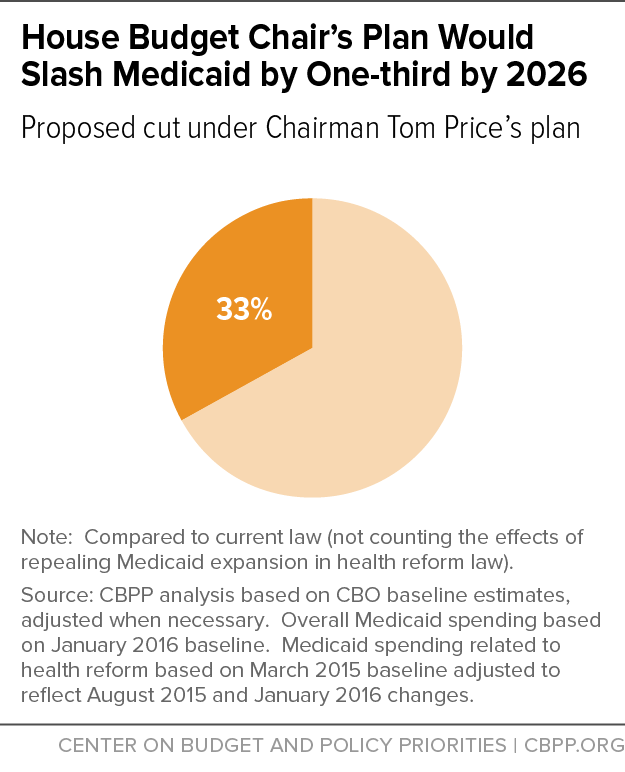BEYOND THE NUMBERS
House Budget Committee Chairman Tom Price’s budget plan would radically restructure Medicaid by converting it to a block grant, cutting federal funding by about $1 trillion over the next decade. It would also repeal health reform’s Medicaid expansion. The combined result would be a total Medicaid cut of $2.1 trillion over the next ten years, relative to current law, likely making tens of millions of Americans uninsured or underinsured.
Repealing the Medicaid expansion means that at least 14 million people would lose Medicaid or not get it in the future, based on Congressional Budget Office (CBO) estimates. In addition, the large and growing funding cut from the block grant would almost certainly force states to sharply scale back their Medicaid programs.
The Price plan would also repeal health reform’s other coverage expansions, including the subsidies to help people afford marketplace coverage.
All told, not only would the estimated 20 million Americans who’ve already gained coverage through health reform lose it, but millions more who qualify for Medicaid apart from health reform would likely lose their Medicaid coverage as well. Tens of millions of Americans would likely become uninsured.
Under Price’s “State Flexibilities Funds” block grant proposal, the federal government would no longer pay a fixed share of states’ Medicaid costs, apparently starting in 2018. Instead, states would get a fixed dollar amount of federal funding, which would rise only modestly each year, as explained below.
- Block-grant funding would fall further behind state needs each year. The annual increase in the block grant would average about 4.3 percentage points less than Medicaid’s currently projected growth rate over the next ten years. In the plan’s tenth year (2026), federal Medicaid and Children’s Health Insurance Program (CHIP) funding would be $169 billion — or roughly 33 percent — less than under current law (see graph). And the cuts would likely keep growing after 2026.
- The block grant would cut federal Medicaid funding by $1 trillion from 2017-2026. A small share of these cuts could come from CHIP, which the Price plan would presumably merge into the Medicaid block grant as in past House Republican budget plans. Over the next ten years (2017-2026), the budget plan would provide nearly 25 percent less in federal Medicaid and CHIP funding to states than under current law — not counting the lost federal funding for the Medicaid expansion.
- The loss of federal funding would be greater in years when enrollment or per-beneficiary health care costs rose faster than expected — for example, due to a recession or new treatment that improved patients’ health but raised costs. Currently, the federal government and the states share in those unanticipated costs; under the Price plan, states alone would bear them.
As CBO concluded in 2012 when analyzing a similar Medicaid block grant from then-House Budget Committee Chairman Paul Ryan:
the magnitude of the reduction in spending . . . means that states would need to increase their spending on these programs, make considerable cutbacks in them, or both. Cutbacks might involve reduced eligibility, . . . coverage of fewer services, lower payments to providers, or increased cost-sharing by beneficiaries — all of which would reduce access to care.
In making these cuts, states would likely use the large added flexibility that the Price plan would give them. For example, the plan would likely let states cap Medicaid enrollment and turn eligible people away from the program, or drop benefits that people with disabilities or other special health problems need.
The Urban Institute estimated that the 2012 Ryan proposal would lead states to drop between 14.3 million and 20.5 million people from Medicaid by the tenth year (outside of the effects of repealing health reform’s Medicaid expansion). That’s an enrollment decline of 25 to 35 percent. Urban also estimated that the Ryan plan would lead states to cut reimbursements to health care providers by more than 30 percent. The Price block-grant proposal likely would mean similarly draconian cuts.

